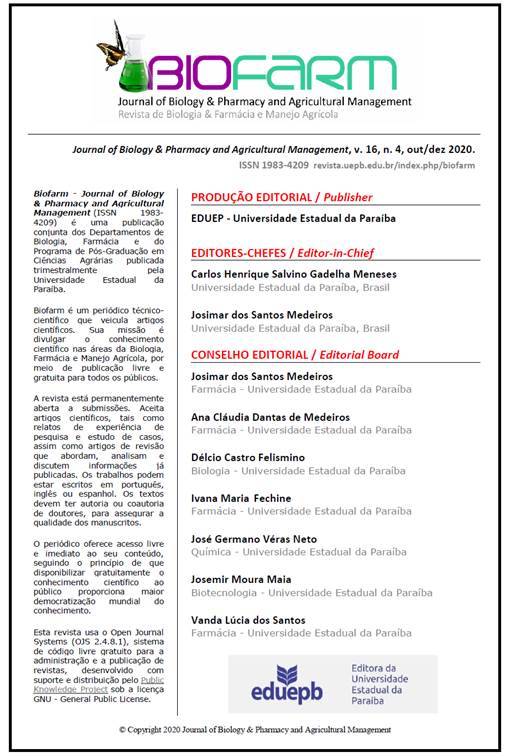ESTRUTURA FITOSSOCIOLÓGICA DO ESTRATO LENHOSO EM ÁREA DE REGENERAÇÃO NATURAL NO BIOMA CAATINGA (SÃO MAMEDE, PB)
Resumo
Estudos sobre a estrutura florestal lenhosa no Bioma Caatinga são raros. Sendo este o objetivo desta pesquisa, com análise de áreas em regeneração natural (São Mamede-PB). Para tal foi realizado um levantamento florestal (15 parcelas de 20 x 20 m), com os critérios: circunferência na altura do peito (CAP) (≥ 6 e ≥ 9 cm, critérios 1C e 2C, respectivamente) para todos indivíduos (IND) com altura ≥ 1 m. Os dados de CAP < 9 cm, foram usados para a verificação da regeneração natural (RN). Como resultados para 1C: 1.016 IND [11 espécies (ESP), 10 gêneros (GEN) e 6 famílias (FAM)] com área basal (AB) de 5,14 m2.ha-1 e para 2C: 1.200 IND [13 ESP, 12 GEN e 7 FAM] e AB de 11,10 m2.ha-1. Foram mais abundantes IND das famílias Fabaceae e Euphorbiaceae; maior relevância para as espécies Aspidosperma pyrifolium, Mimosa tenuiflora, Croton blanchetianus (nos dois critérios). Foi constatada alta similaridade entre a maioria das parcelas. Na RN foram levantados 169 IND de 8 ESP, distribuídas em 7 FAM. A área em destaque está em um processo de regeneração conforme informações relatadas sobre o bioma Caatinga na literatura.
Downloads
Publicado
Como Citar
Edição
Seção
Licença
Copyright (c) 2023 BIOFARM - Journal of Biology & Pharmacy and Agricultural Management

Este trabalho está licenciado sob uma licença Creative Commons Attribution 4.0 International License.
Authors and co-authors retain copyright, but cede the right to first publication to the Journal of Biology & Pharmacy and Agricultural Management (BIOFARM).
Copyright encompasses exclusive rights to reproduce and deliver the article in all form and media, including reprints, photographs, microfilms and any other similar reproductions, as well as translations. The reproduction of any part of this journal, its storage in databases and its transmission by any form or media - such as electronic, electrostatic and mechanical copies, photocopies, recordings, magnetic media, etc. - will be allowed only with a written permission from the BIOFARM.
Articles published in BIOFARM will be Open-Access articles distributed under the terms and conditions of the Creative Commons Attribution License (CC BY). The copyright is retained by the author(s). BIOFARM will insert the following note at the end of the published text:
© 2023 by the authors; licensee BIOFARM, Campina Grande, Brazil. This article is an open access article distributed under the terms and conditions of the Creative Commons Attribution License (http://creativecommons.org/licenses/by/4.0/).


